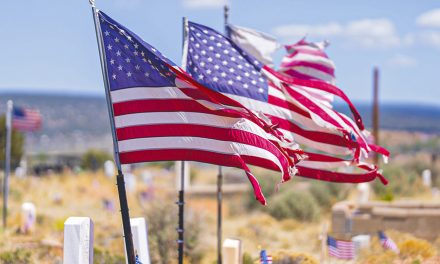
Council approves direct payments from CARES fund
WINDOW ROCK
With any luck, the Navajo people and their 110 chapters might soon be eligible for direct financial relief from the remaining pot of $176 million in CARES Act money. That is, if President Jonathan Nez signs two bills that were passed by the Navajo Nation Council last Friday.
As of Sept. 21, $538 million of the $714 million Navajo CARES Act funds had been appropriated, with only $30 million spent and $12 million encumbered, leaving $176 million yet to be allocated.
Legislation No. 0201-20, sponsored by Delegate Eugenia Charles-Newton (passed 21-0), adds $49 million to the CARES Fund Hardship Assistance Expenditure Plan that was adopted in Resolution CJY-67-20 and originally established with only $1,000.
The purpose of the Charles-Newton’s legislation is to provide emergency financial assistance, necessary to combat the effects of COVID-19 and mitigate the spread of the virus, to Navajo tribal members. “This money goes directly to the people,” said Charles-Newton. “We are all aware that our people are in a financial crisis and they need help. COVID-19 has affected every single Navajo person living on and off the reservation.”
No. 197-20, sponsored by Delegate Mark Freeland (passed 21-0), established the CARES Fund Chapter Distribution Expenditure Plan, which allocates $90 million to all chapters under the 50-50 formula (half divided equally among the chapters and half based on population), for COVID-19 humanitarian relief and response efforts.
The bill also includes $20 million for the controller’s office to handle disbursement of the funds through an online portal, $2 million to the Division of Community Development to help administer the funds, and $15 million for telecommunications and internet connectivity for chapters, for a total of $127 million.
$1,500 for adults, $500 for minors
The $49 million approved by Council in No. 0201-20 would be available to all 327,726 Navajo enrolled tribal members (CIB required) on and off the reservation through an application process that would be managed through the controller’s office.
As a public service, the Navajo Times is making all coverage of the coronavirus pandemic fully available on its website. Please support the Times by subscribing.
How to protect yourself and others.
Why masks work. Which masks are best.
Resources for coronavirus assistance
Adults 18 years and over as of March 1 could qualify for direct payments of $1,500, and children 17 and under could qualify for $500. Eligibility would not be restricted or income-based, said Charles-Newton.
Details on the application process for the hardship assistance are still being worked out. The $49 million would not be able to accommodate all 327,000 tribal members so it appears that distribution would occur on a first-come, first-served basis.
Originally, Charles-Newton’s bill started off with a proposed $175 million but that had to be reduced by the $127 million (via amendment) that was passed in Freeland’s legislation just prior.
There is a possibility that other funds that are not encumbered for projects and services by Oct. 1 will revert or can be transferred either to the general CARES Fund or the hardship assistance fund.
This means there is some hope that the $49 million could be supplemented to offer more hardship relief to more people, which would have to be approved by the Budget and Finance Committee and Council.
For example, Resolution CJY-67-20 states that funding for any project that has not made enough progress to demonstrate that it will be fully completed by Dec. 30, will be re-allocated to the Hardship Assistance Expenditure Plan through Naabik’iyati Committee resolution.
‘The 9th hour’
Charles-Newton said that Council delegates did their best to meet the needs of the people by appropriating funds for infrastructure and services through three prior CARES Act bills, but delays in spending those funds through the executive branch have been untenable. “We immediately jumped into action when that money was dispersed to us,” she said.
The first $600 million-plus in CARES Act funds arrived in the Nation’s coffers on May 5, which was based on Navajo census population data. “Right now, we have money sitting in these program accounts and the programs are moving at a snail’s pace,” said Charles-Newton. “Unfortunately, we can’t access any more than what’s left over.”
There are still many unknowns at this point because neither the legislative nor executive branch has provided public updates about the progress of spending the appropriated CARES Act monies. “We are at the ninth hour,” said Charles-Newton. “We need to start spending this money or it goes back to the federal government. I would rather our people have this money and use it for the things that they need to survive through the winter and provide for their families.”
Controller Pearline Kirk told delegates that in addition to the time and effort it will take to process applications and disperse the hardship assistance payments through her office’s portal, yet to be developed, outreach and education will be required to inform the public of the process for obtaining funds. Kirk did, however, express support for Charles-Newton’s bill because it could get the money out quickly and efficiently. “
Now is the time to move to something like a hardship assistance,” said Kirk. “Our best bet is to automate this. That way the checks are just being printed.” Kirk also informed delegates that her office has discovered that some of the projects that had been approved in prior legislations were “unallowable” under CARES Act expenditure guidelines. She said decisions need to be made by the Budget and Finance and Naabik’iyati committees to identify projects that can’t be completed by Dec. 30 or are non-allowable to figure out how much money can be reallocated or transferred to provide for other expenditures.
Empowering chapters
With regard to the Chapter Distribution Expenditure Plan, Freeland said while some have expressed concerns about misuse of funds and nepotism at the chapter level, the $90 million available to chapters through No. 197-20 would be “vetted” and administered through Window Rock.
“The most efficient way to distribute funds and expedite procurements is through online portals through the (controller’s office), with assistance from DCD,” he said. “Everything’s going to be centralized in Window Rock.”
He explained that the money will not actually be transferred directly to the chapters, but the chapters, similar to individuals applying for hardship assistance, would have to log into the controller’s office portal and request funds. Freeland said chapters will have to prepare community needs assessments with budgets and chapter administrative staff will process all funding requests to make sure they meet CARES Act criteria that require all expenditures be “necessary” and “due to” the COVID-19 public health emergency.
In turn, Freeland clarified, individual registered chapter members would also be able to request hardship assistance from their chapter.
Freeland believes No. 197 can empower the chapters to combat COVID-19 in their communities and help their people. “This is an opportunity to utilize our chapters as a resource,” said Freeland. “They know who in their communities are in need and at high risk.”
Eligible expenses outlined in the chapter plan include food, water, utilities, propane, gasoline, wood, PPE, sanitation supplies, and equipment such as backhoes needed for burials.
Competing bills
What could throw a kink in the chain for both No.s 197-20 and 201-20 is that the president’s office has been advocating for the passage of yet another bill that can’t be considered yet because there are no more funds available to appropriate.
In other words, there is an incentive for Nez to veto the two bills headed for his desk to free up money for the bill he favors. No. 209-20, sponsored by Delegate Kee Allen Begay and crafted with Nez, would appropriate a total of $176 million as follows: College students ($35 million); Former Bennett Freeze Area housing ($25 million); tech services for employees and students ($3 million); safety modifications for Head Start centers ($4.3 million); hardship assistance for school children ($5 million); remote work for Social Services ($5 million); safety improvements for Navajo Nation Shopping Centers ($4 million); internet for chapters ($15.4 million); propane and natural gas ($7.4 million); solar projects ($15 million); solid waste disposal ($5 million); IT services ($1 million); police, fire, and EMS internet ($602,000); Controller’s office ($10 million); Office of Management and Budget ($653,000); and emergency assistance for elders and those with disabilities ($39.9 million).
“The final CARES Act funding proposal (209-20) created by the Nez-Lizer administration reflects the immediate and essential needs of our Navajo people related to the coronavirus,” Nez said on Sept. 1. “We must join together to move the legislation forward.” As Kirk suggested, with only 90 days left to spend the monies, the quickest path to do so might just be the best option.
“We’re running up against the clock,” said Charles-Newton. “What I worry about is giving that money back. How would we explain that to the people?”








 Highway 264,
Highway 264, I-40, WB @ Winslow
I-40, WB @ Winslow